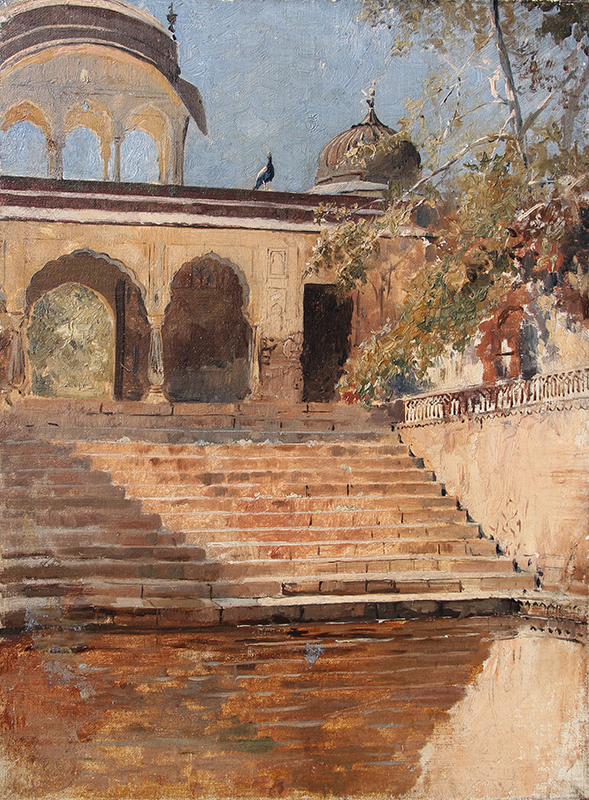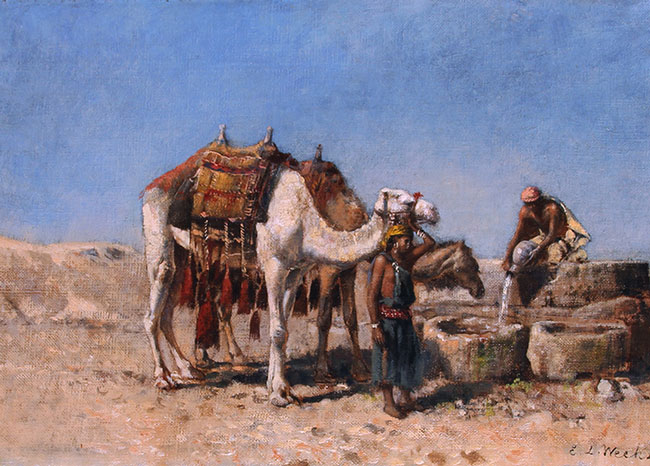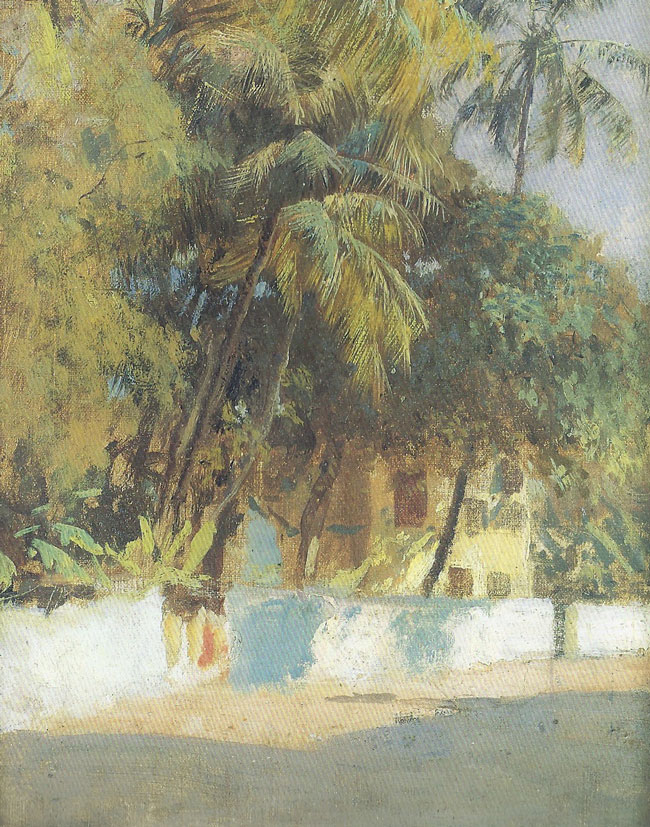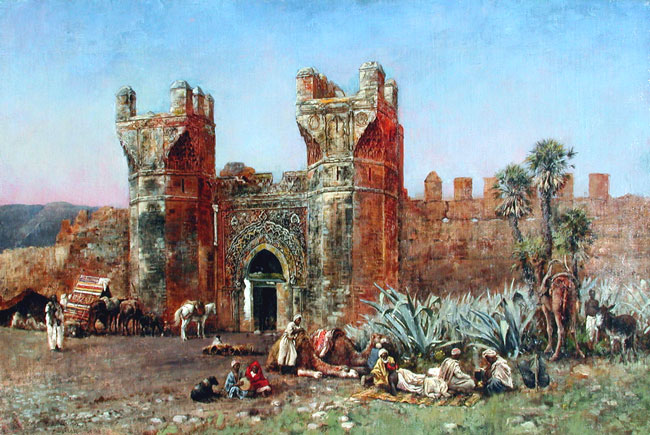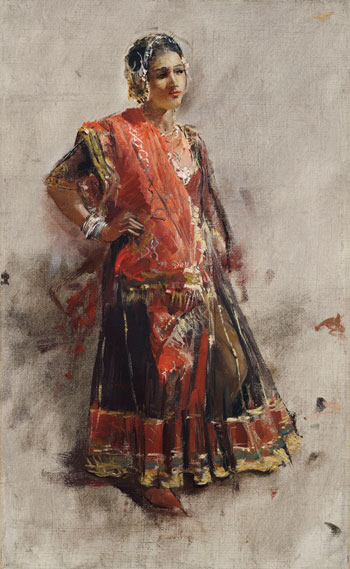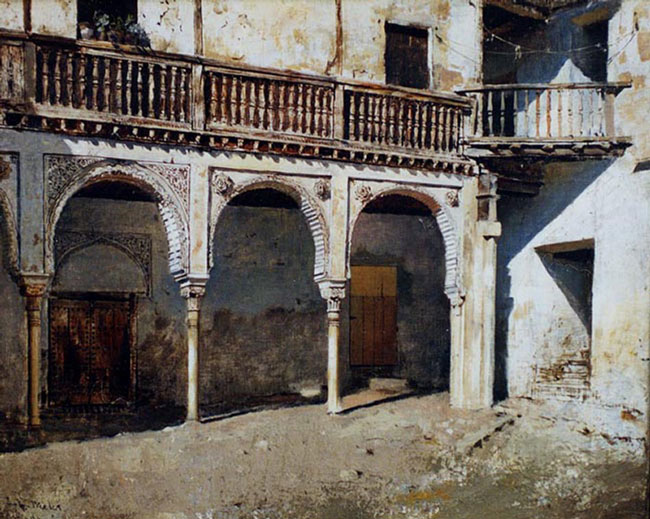EDWIN LORD WEEKS PAINTINGS FOR SALE & BIOGRAPHY
EDWIN LORD WEEKS
American, 1849–1903
BIOGRAPHY
A native of Newtonville, near Boston, Massachusetts, the painter, illustrator, and author Edwin Lord Weeks was educated in Boston and Newton. In 1869, he began the first of many travels with a sketching trip to Florida. That same year he visited Surinam and other places in South America. On his return to Boston, he painted history pictures and landscapes, which his friend Samuel G.W. Benjamin (1837–1914) described as “pleasing woodland scenes.” Between 1869 or 1870 and 1871, Weeks studied in Paris at the École des Beaux-Arts under Jean-Léon Gérôme (1824–1904) and also in the atelier of Léon Bonnat (1834–1922). Perhaps inspired by Gérôme’s exotic subjects, he traveled in North Africa, the Middle East, and Spain, accompanied for part of the trip by another artist, A.P. Close, who died in Beirut. In 1871, Weeks returned to Newtonville, where he opened a studio and married Frances Rollins Hale of Rollinsford, New Hampshire. The following year the couple joined the Scottish painter Robert Gavin (1827–1883) for a trip to the Mediterranean and Morocco. Although little is known about Weeks’s activities between 1872 and 1878, it is thought that he spent a good deal of time in Morocco. He also seems to have returned to Boston during this period, for in 1874 he was mentioned as having a studio decorated in the oriental manner there, and in 1876 he exhibited at the Boston Art Club. It was probably at this time that he prepared the illustrations that appear in C.J. Maynard’s The Naturalist’s Guide in Collecting and Preserving Objects of Natural History, with a Complete Catalogue of the Birds of Eastern Massachusetts (1877), which was published in Salem.
Weeks returned to Paris by 1880 and spent the remainder of his career as an expatriate. His travels during the 1880s are not well documented, but it is known that he spent some time in India. He was there for a year from 1882 to 1883 and returned to Jodhpur in 1887. In July 1892, he set out on an extended journey through Turkey, Persia, and India with Theodore Child, a scholar of Russian affairs. Weeks recorded the adventures of this trip and his impressions of the Middle East and Asia in a series of copiously illustrated articles that appeared in Harper’s between 1893 and 1895 in book form as From the Black Sea through Persia and India (1896). His writings and drawings also appeared in Scribner’s magazine. During the 1890s, Weeks achieved international recognition as a writer and painter. In 1896, he was made a knight of the French Legion of Honor and, two years later, an officer of the Order of St. Michael of Bavaria.
Art historians have examined Weeks’s artistic development, but most of his works, particularly those dating from the 1890s, are untraced. Of those that are located, few are dated. His pictures cannot be dated accurately by subject alone, for he seems to have based some of his large works on earlier drawings, sketches, and photographs. Beginning in the 1870s, when he assumed the realistic style and the exotic subject matter of his teacher Gérôme, Weeks’s development can be seen within the context of French academic painting. Departure from the Stronghold (Maryland art market) is perhaps typical of the painterly style that he favored during this decade. Works from the 1880s like The Gate at the Fortress at Agra (Union League of Philadelphia) and The Great Mogul and His Court Returning from the Great Mosque at Delhi, India (Portland Museum of Art, Maine) display a drier, more detailed realism, which may be the result of his experiments in photography. During the last years of his life, Weeks worked on an important series of paintings, One Thousand and One Nights, but the works remain untraced.
Two years after his untimely death in 1903, his widow sold the contents of his Paris studio and some 277 paintings and sketches at auction in New York.
(Burke, Doreen Bolger, American Paintings in the Metropolitan Museum of Art, Vol. III, A Catalogue of Works by Art and Artists Born between 1846 and 1864, 1980).
Museum Collections:
Annmary Brown Memorial, Providence, RI
Appleton Museum of Art, Ocala, FL
Art Institute of Chicago, Chicago, IL
Brooklyn Art Museum, Brooklyn, NY
Berkshire Museum, Pittsefield, MA
Dallas Museum of Art, TX
Joslyn Art Museum, Omaha, NE
Los Angeles County Museum Art, Los Angeles, CA
Metropolitan Museum of Art, New York, NY
Musée d’Art et d’Industrie, Roubaix
Musée du Louvre, Paris
Musée d’Orsay, Paris
Museo Thyssen-Bornemisza, Madrid
Newton History Museum, MA
Philadelphia Museum of Art, Philadelphia, PA
Portland Museum of Art, Portland, ME
San Diego Museum of Art, CA
Smithsonian American Art Museum, Washington, D.C.
Syracuse University Art Galleries, Syracuse, NY
Telfair Museum of Art, Savannah, GA
Virginia Museum of Fine Arts, Richmond, VA
Walters Art Museum, Baltimore, MD
Mark Murray Fine Paintings is a New York gallery specializing in buying and selling 19th century and early 20th century artwork.
Edwin Lord Weeks: An Appreciation
Touch below to watch the movie
EDWIN LORD WEEKS
Paintings for sale
Currently there are no available Edwin Lord Weeks paintings for sale at the Mark Murray Gallery.
Please contact us if you are interested in selling your Edwin Lord Weeks paintings or other artwork from the 19th century and early 20th century.
Edwin Lord Weeks Paintings Previously Sold
EDWIN LORD WEEKS
Rialto Bridge, Venice
Oil on board
8½ x 10½ inches (21.6 x 26.7 cm)
SOLD
EDWIN LORD WEEKS
Sacred Lake, Bombay
Oil on board
10½ x 8¾ inches (26.6 x 22.3 cm)
SOLD
EDWIN LORD WEEKS
Elephants of Bekanir
Oil on canvas
13 x 20 inches (33 x 51 cm)
SOLD
Additional Edwin Lord Weeks Paintings for Sale
EDWIN LORD WEEKS
At the Barber’s
Oil on canvas
24 x 37 inches (61 x 94 cm)
SOLD
EDWIN LORD WEEKS
Les Éléphants du Rajah de Jodhpore
Oil on canvas
18½ x 22 inches (47 x 55.9 cm)
SOLD
EDWIN LORD WEEKS
Camels at a Well, Tangiers
Oil on canvas
10½ x 15½ inches (26.6 x 39.3 cm)
SOLD
EDWIN LORD WEEKS
Two Nautch Girls
Oil on canvas
23 x 18¼ inches (58.5 x 46.3 cm.)
SOLD
EDWIN LORD WEEKS
Street Scene, Bombay
Oil on canvas laid down on board
10¾ x 8¾ inches (27.3 x 22.3 cm.)
SOLD
EDWIN LORD WEEKS
Temples and Steps – Benares, India (1883)
Oil on canvas
18½ x 28 inches (47 x 71 cm.)
SOLD
EDWIN LORD WEEKS
Study of a Man
Oil on canvas
13½ x 9½ inches (34.2 x 24 cm.)
SOLD
EDWIN LORD WEEKS
View in Benares
Oil on board
12 x 18 inches (30.5 x 45.6 cm.)
SOLD
EDWIN LORD WEEKS
A Distinguished Visitor
Oil on canvas
18¼ x 15 inches (46.4 x 38 cm.)
SOLD
EDWIN LORD WEEKS
Two Hindu Men - India
Oil on canvas
20¾ x 13 inches (52.5 x 33 cm.)
SOLD
EDWIN LORD WEEKS
Palanquin and Bearers - Agra
Oil on canvas
20 x 24 inches (50.8 x 61 cm.)
SOLD
EDWIN LORD WEEKS
The Rajah's Elephant
Oil on board
11½ x 6¾ inches (29.5 x 17.2 cm.)
SOLD
EDWIN LORD WEEKS
Study of a Man in a Red Cap (c. 1892)
Oil on canvas
15 x 9½ inches (38 x 24 cm.)
SOLD
EDWIN LORD WEEKS
In the Bazaar, Oudeypore
Oil on canvas board
14 x 18 inches (35.5 x 45.7 cm)
SOLD
EDWIN LORD WEEKS
At the Gate of Shelah - ‘Past and Present’
Oil on canvas
24 x 36 inches (61 x 91.4 cm.)
SOLD
EDWIN LORD WEEKS
Man in Armor
Oil on canvas
18½ x 12½ inches (47 x 31.7 cm.)
SOLD
EDWIN LORD WEEKS
Camels and Caravan
Oil on board
11 x 18¼ inches (28 x 46.4 cm.)
EDWIN LORD WEEKS
A Venetian Canal
Oil on canvas
13 x 16 inches (33 x 40.6 cm.)
SOLD
EDWIN LORD WEEKS
Bombay
Oil on board
8¾ x 10½ inches (22.2 x 26.7 cm.)
SOLD
EDWIN LORD WEEKS
Shops in Native Quarter—Lahore, India
Oil on canvas
20 x 12½ inches (50.8 x 31.7 cm.)
SOLD
EDWIN LORD WEEKS
Watering Horses on the Euphrates
Oil on board
10¼ x 16¼ inches (26 x 41 cm.)
SOLD
EDWIN LORD WEEKS
Temples and Bathing Ghat - Benares, India
Oil on canvas
18½ x 28 inches (47 x 71 cm.)
SOLD
EDWIN LORD WEEKS
Procession beneath the Palace of Man Singh, Gwalior
Charcoal on paper
18 x 22 inches (45.7 x 55.9 cm.)
SOLD
EDWIN LORD WEEKS
Indian Dancing Girl
Oil on canvas
16 x 9¾ inches (41 x 24.8 cm)
SOLD
EDWIN LORD WEEKS
Interior of La Torre des Infantas, The Alhambra
Oil on canvas
10 x 12¼ inches (25.4 x 30.5 cm)
SOLD
EDWIN LORD WEEKS
Along the Ghats, Mathura
Oil on board
16½ x 23 inches (42 x 58.3 cm)
SOLD
EDWIN LORD WEEKS
A Portico in Ahmedabad, India
Oil on canvas
21¾ x 18½ inches (55.2 x 47 cm.)
SOLD
EDWIN LORD WEEKS
Elephant belonging to the Maharajah of Bikanir
Oil on canvas
20 x 13 inches (51 x 33 cm.)
SOLD
EDWIN LORD WEEKS
Love-making at Oodeypore
Oil on canvas
26 x 37 inches
SOLD
EDWIN LORD WEEKS
Scene at Salé, Morocco
Oil on canvas
24 x 36 inches (61 x 91.4 cm.)
SOLD
EDWIN LORD WEEKS
Courtyard in Granada
Oil on canvas
18¾ x 23½ inches (47.6 x 59.7 cm.)
SOLD
EDWIN LORD WEEKS
Woman in Yellow
Oil on canvas
20 x 12¼ inches (50.8 x 31 cm.)
SOLD
EDWIN LORD WEEKS
Palace and Lake at Sarkeh, near Ahmedabad, India
Oil on canvas
20½ x 30½ inches (52 x 77.5 cm.)
SOLD
EDWIN LORD WEEKS
In the Native Quarter - Ahmedabad
Oil on canvas
12 x 16 inches (30.5 x 40.6 cm.)
SOLD
EDWIN LORD WEEKS
Ramparts du Quartier du Ondais, Rabat (1879)
Oil on canvas
12 x 19½ inches (30.5 x 50 cm.)
SOLD
EDWIN LORD WEEKS
Persian Mother and Child
Oil on board
11½ x 19 inches (29.2 x 48.2 cm.)
SOLD
EDWIN LORD WEEKS
A Seated Zouave
Oil on canvas
18 x 11½ inches (45.7 x 29 cm.)
SOLD
EDWIN LORD WEEKS
Native Gharry, Ahmedabad (1882)
Oil on canvas
20½ x 30½ inches (52 x 77.4 cm)
SOLD
For more information on Edwin Lord Weeks see these additional resources:
WikiArt: http://www.wikiart.org/en/edwin-lord-weeks








